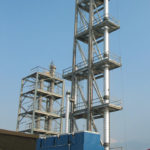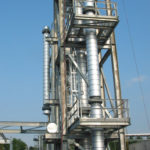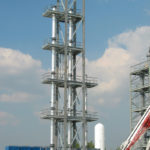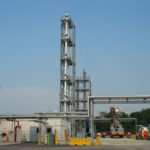Project Synopsis
Rate an existing petrochemical distillation tower train for use in a new service and design a new distillation system if the existing towers were found to be inadequate.Project Summary
NEW HIGH PURITY PROPYLENE DISTILLATION PROCESS DESIGN
Process Engineering Associates, LLC (PROCESS) was contracted by the client, a producer of aerosol propellants, fuels, and refrigerants, to provide process design and engineering services for a distillation train to produce high-purity (99.995%) propylene from polymer grade propylene. Specifically, PROCESS was contracted to complete the following project tasks: Task 1 – rate the existing distillation towers for use in this new service; and Task 2 – design new distillation towers and associated equipment for this service if the existing towers were found to be inadequate.
For Task 1, PROCESS‘ licensed computer process simulation software, CHEMCAD, was used to rate the existing distillation columns for high-purity propylene production. Sensitivity studies were performed to bound the possible operating conditions, including distillate temperature, feed location, and reflux ratio. The high-purity requirement and the close boiling components present significant challenges for conventional fractionation in this application. Due to the difficulty of the separation and the limited number of trays in the existing columns, it was found that the existing equipment was inadequate for the new service. Although it may be technically feasible to perform the separation in the existing equipment, capacity and product recovery limitations, as well as required utilities, made this option impractical.
Task 2 subtasks included the following:
- Mass and energy balance development
- Process Flow Diagram (PFD) development
- Piping and Instrumentation Diagram (P&ID) preparation
- Process control description development
- Equipment specifications preparation.
For this task, PROCESS used CHEMCAD to develop a complete mass and energy balance for the new distillation train. The train consists of two columns. The first column removes ethane and other light end impurities, while the second column separates the propylene from impurity levels of propane and other compounds. Sensitivity studies were performed to arrive at the optimal number of stages, feed location, reflux ratio, reflux temperature, and product recovery. Additionally, a preliminary capital cost sensitivity analysis was performed to fine tune the optimal number of stages and column diameter. These studies were used to define the operating conditions shown in the PFD. From this design information, the P&IDs and process control description were developed. The nature of the separation requires complex controls, which will be challenging to operate while maintaining consistent quality.
Equipment specifications were prepared for all new equipment items associated with the process. Preliminary duty specifications were prepared for pumps, control valves, tanks, and a chiller package. Purchase-grade, complete mechanical specifications were prepared for the columns and the heat exchangers. Due to the number of required stages, and the resulting overall height, the propylene purification column was designed as two columns. The shell and tube heat exchangers were designed using CCTHERM heat exchange rating and design software.
The design of a high-purity propylene distillation process presented challenges to the design team. No data exist to validate the simulation results. Few producers exist world-wide, and they produce small quantities using specialized equipment that includes more than simple fractionation. The design team took additional steps to validate the design. Equipment and technology suppliers were consulted, and the simulation results from CHEMCAD were compared with results from other simulation software. Additionally, sensitivity studies comparing product purity and required number of stages were performed to gauge the robustness of the design with respect to changing feed stocks, as well as to determine how conservative the design is.
The client later reported that they completed their first trial run and achieved the 99.995% propylene purity goal, thus validating PROCESS‘ design of the fractionation system for this extremely difficult application.
Industry Type
- Petrochemical Derivatives
Utilized Skills
- Distillation system modeling and evaluation
- High purity distillation systems design
- Product specification sensitivity analysis
- Process equipment cost sensitivity analysis




